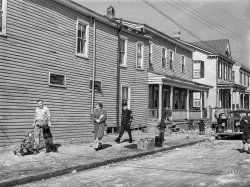
MAY CONTAIN NUTS

Search Shorpy
SHORPY ART

Framed or unframed, desk size to sofa size, printed by us in Arizona and Alabama since 2007. Explore now.
Join and Share
Ad-Free Shorpy
Shorpy is funded by you. Patreon contributors get an ad-free experience.
Learn more.

Recent comments
- Baldwin 62303
- Baldwin VO-1000
- Cold
- No expense spared
- Tough Guys
- Lost in Toyland
- And without gloves
- If I were a blindfolded time traveler
- Smoke Consumer Also Cooks
- Oh that stove!
- Possibly still there?
- What?!?
- $100 Reward
- Freeze Frame
- Texas Flyer wanted
- Just a Year Too Soon
- WWII -- Replacing men with women at the railroad crossing.
- Yes, Icing
- You kids drive me nuts!
- NOT An Easy Job
- I wonder
- Just add window boxes
- Icing Platform?
- Indiana Harbor Belt abides
- Freezing haze
- Corrections (for those who care)
- C&NW at Nelson
- Fallen Flags
- A dangerous job made worse
- Water Stop
Member Photos
The Shorpy
Print Emporium
Print Emporium
Search Shorpy
Search results -- 30 results per page
- Best Friends: 1938
- ... Nebraska." 35mm nitrate negative by John Vachon for the Farm Security Administration. View full size.
Dog Point Here in the quail ... Posted by Dave - 08/02/2017 - 9:24am -

- Nightspot: 1941
- ... Chicago, Illinois." Safety negative by Russell Lee for the Farm Security Administration. View full size.
Martin Dreadnaught! What I ... Posted by Dave - 09/13/2011 - 2:02pm -
![Nightspot: 1941 April 1941. "Entertainers at South Side tavern. Chicago, Illinois." Safety negative by Russell Lee for the Farm Security Administration. View full size.
Martin Dreadnaught!What I wouldn't give to have the guitar being played by the man in the center! Built by the C.F. Martin Company of Nazareth, Pennsylvania, it's a D-18. Hank Williams, Elvis, and other too numerous to mention played something similar.
LonnieCould the guitarist on the right possibly be Lonnie Johnson? He'd have been 42 at the time, and was I believe based in Chicago in the early Forties. Looks a lot like him anyway.
No reason for the photographer to know that he was snapping someone who'd played with Armstrong and Ellington, and is now seen as one of the great pioneers of blues/jazz guitar.
The woman in the mirroris beautiful. I wonder if she's a partygoer or an employee? Sure wish we had sound with these pictures!
The CrowdStylishly well dressed and enjoying the show.
Classy Good TimesI don't think you can find places like this anymore where class and dignity upgrade the enjoyment of the music, cocktails and fun. I like the lady in the fedora in the back booth looking directly at the camera like she knows more than most and the elegance displayed by all the good company present. Don't know why, but it brings to mind a little-known song sung by LaVern Baker (born in Chicago in 1929) called "Saved" which is a real hoot with words something like "I used to smoke, I used to drink, I used to do the hootchy coo, but now I'm saved..." and there is a big Salvation Army drum booming in the background. I'll have to look that up and have another listen. Anyway, thank you Shorpy for the provacative photo, just another one of which takes me back to younger days. Chicago, Chicago, a toddlin' town...
GuitarsThe guitar on the left is a 28 series Martin - you can tell by the white binding. It does look like a Dreadnought size, which surprises me. Man on the right has a Martin 00-21, which Lonnie Johnson played.
LonnieMick H could be right. The resemblance to Lonnie Johnson is striking.
[More Lonnie here. - Dave]
Cool EleganceAs requested below ... A sampling of Lonnie Johnson's music from 1927-1947. I imagine he played one of these during a set. Ladies in hats and men including the musicians in suits and ties you just can't get gigs like that anymore.
She's My Mary 1939
Two Tone Stomp 1928
Nothing But Trouble
Have To Change Keys To Play These Blues 1928
Tomorrow Night 1948
Flood Water Blues 1937
Mean Old Bedbug Blues 1927
Swing Out Rhythm 1937
Playing With The Strings 1928
Jelly Roll Baker
No More Troubles Now 1930
Guitar Blues 1929
Tomorrow Night 1947
Got The Blues For The West End 1937
Pleasing You As Long As I Live 1948
Blues In My Soul 1947
(The Gallery, Chicago, Eateries & Bars, Music, Russell Lee)](https://www.shorpy.com/files/images/8c00682u.thumbnail.jpg)
- On the Road: 1939
- ... Medium format nitrate negative by Dorothea Lange for the Farm Security Administration.
Travelin' Man No doubt he had many ... Posted by Dave - 07/30/2012 - 2:43pm -
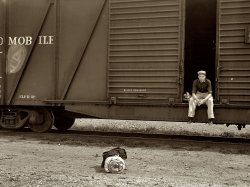
- Brattleboro Blizzard: 1940
- ... blizzard." Acetate negative by Marion Post Wolcott for the Farm Security Administration. View full size.
How Vermont Cities Change ... Posted by Dave - 05/08/2019 - 1:26pm -
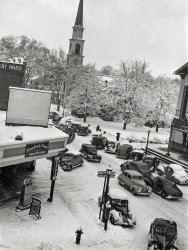
- No Man's Land: 1940
- ... borrower operating tractor. She and her mother run the farm without the assistance of any men." Medium format acetate negative by John Vachon for the Farm Security Administration. View full size.
What she needs is a hat.
... Posted by Dave - 02/15/2020 - 1:11pm -
![No Man's Land: 1940 May 1940. Grant County, Illinois. "FSA rehabilitation borrower operating tractor. She and her mother run the farm without the assistance of any men." Medium format acetate negative by John Vachon for the Farm Security Administration. View full size.
What she needsis a hat.
Not surprisingUntil probably the 1950s, women in America worked really hard all day long, and pretty much drudge work at that. Much harder than men, in general, or at least a lot more continuous work. Running a tractor doesn't require a man's physical advantages, it takes a lot of stick-to-itiveness. It was probably notable at the time, hence the underlying "shock" of the original caption, but arguably it's easier than doing endless manual housework like scrubbing clothes by hand and trying to feed a family 3 meals a day from a huge cast-iron wood stove.
MaintenanceThe hard part is the repairing, not the driving.
KilljoysThe clutch-operation instruction sticker located just ahead of the operator shows just what sticks in the mud the builders of this equipment really were. After all, where's the fun in having all those gears if you can't speed-shift?
Good for her!I assume the tractor is a Fordson? That's what it looks like. They were called widowmakers, for their propensity to pop wheelies.
I must say, as someone typically assumed to be a dude, I'm thrilled to see a woman named as an "FSA borrower" rather than as a wife thereof. Those women worked just as hard as the men, and they deserve the credit.
And who says she didn't repair her own tractor?
Tractor IDMcCormick-Deering 10-20, perhaps?
[It is indeed a McCormick-Deering. Click below to embiggen. - Dave]
Grant County?The label appears to be wrong; there is currently no Grant County in Illinois. It looks like there's a Grant Township in Illinois or Grant County, Wisconsin.
[Vachon did take 20 photos labeled Grant County, Wisconsin, so perhaps this is there. - Dave]
HarvesterNot an expert, but: The tractor looks like an early 1920's McCormick-Deering brand (part of International Harvester). In 1923 McCormick and Deering (both IH) had to reduce to one dealer per region as part of a US antitrust suit. Maintaining a battered 17-year-old tractor had to be fun.
So that's what they meantThe farming area I grew up in had occasional signs along the roads: "Tractors with lugs prohibited." Quite understandable.
I believe my parents had one of these tractors to work our orchard.
(The Gallery, Agriculture, John Vachon)](https://www.shorpy.com/files/images/SHORPY-8c17526a.thumbnail.jpg)
- Expect Delays: 1939
- ... Medium format negative by Arthur Rothstein for the Farm Security Administration. View full size.
Illinois backroads. I was ... Posted by Dave - 11/28/2017 - 7:54pm -
![Expect Delays: 1939 January 1939. "Highway in Franklin County, Illinois." Medium format negative by Arthur Rothstein for the Farm Security Administration. View full size.
Illinois backroads.I was stationed at Chanute AFB in Champaign County, Iliinois in the early '70's and my friends and I all had street legal dirt bikes that we rode all the county and environs. It was all farm roads and four digit state roads, mostly unpaved, that allowed us to go just about anywhere without traveling on a paved road for miles. Great fun!
Two signsI think I'd turn around, head back the way I came and not take any chances.
L.E. DirdenLoren Edgar Dirden was born in 1890 in Carmi Illinois and died in 1967 in Franklin County Illinois. A draft card from 1941 can be found in a document called "Old Mans Draft Cards, Franklin County Illinois". He was 51 at the time.
"Expect Delays"This is where any road gets interesting!
Terrible TwosdayWell, between this and the foregoing Private Entrance: 1936, it looks like a good day to have pulled the covers over one's head and maybe try it again on Wednesday.
Canary in a Coal MineFranklin Co. was a bustling hub of mining when this photo was taken. More than a dozen mines operated then, including the one seen in the background here, providing rapid count growth in the early part of the 20th century. It also made for a poignant tie to the sign in the photo, "Prepare to meet thy God," as 119 miners lost their lives at the Orient #2 mine on Dec. 21, 1951 due to a methane gas explosion. There was only one survivor.
Going PostalThe front mail box belongs to an H. Butler. In the 1940 census, there was a Hershal Butler living on an "improved road" running west from Hwy 37 and near the Bethel Church, still extant on a route now bisected by I-57. In between the main route and that rural road was the Orient #2 mine mentioned in a prior comment. It's a fairly safe bet that the mine from the 1951 Franlin Co. tragedy is the one depicted in the background here. Fortunately for H. Butler, he was not amongst its victims. He died in 1949.
Mail box questionThe smaller mail boxes with the flapper make sense. One can padlock the box at the top and still receive mail kept from prying eyes. I cannot see what the purpose of the ability of pad locking the type like the large one and getting no mail. Bombs?
[That assembly at the front top of the box isn't for a lock - the lower section serves as a handle for opening the door and also as a latch to secure closure when engaged with the upper part. A lock requiring the carrier to have key in order to deliver mail into a box isn't permitted. -tterrace]
(The Gallery, Arthur Rothstein, Cars, Trucks, Buses, Railroads, Rural America)](https://www.shorpy.com/files/images/SHORPY-8b17426a.thumbnail.jpg)
- The Farmer's Daughter: 1939
- ... of Hillview cooperative who formerly lived in submarginal farm area." Medium format negative by Arthur Rothstein for the Farm Security Administration. View full size.
What a little sweetheart. ... Posted by Dave - 01/20/2018 - 9:47pm -
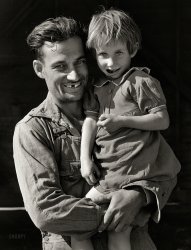
- Texacola: 1940
- ... Medium format negative by Marion Post Wolcott for the Farm Security Administration. View full size.
Looking for a date? Look at ... Posted by Dave - 08/07/2019 - 6:13pm -
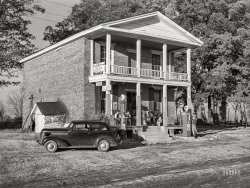
- Speed Dating: 1941
- ... Illinois." Acetate negative by Russell Lee for the Farm Security Administration. View full size.
New Title? Photobomb: 1941 ... Posted by Dave - 09/26/2018 - 10:01am -
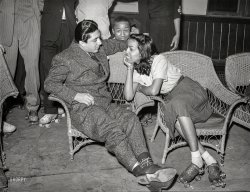
- Maynardville Men: 1935
- ... 35mm nitrate negative. Photograph by Ben Shahn for the Farm Security Administration.
Hunger Look at those gaunt faces; hunger stalks ... Posted by Dave - 07/05/2009 - 2:24am -
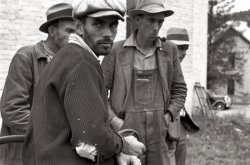
- Petaluma Crater: 1942
- ... Medium format acetate negative by Russell Lee for the Farm Security Administration. View full size.
Eggcrate Skyscrapers! ... Posted by Dave - 04/29/2022 - 9:47am -

- Route 99: 1939
- ... Medium-format nitrate negative by Dorothea Lange for the Farm Security Administration. View full size.
Tough Beginnings This baby ... Posted by Dave - 05/21/2012 - 10:50pm -
![Route 99: 1939 February 1939. "On U.S. 99 near Brawley, Imperial County, California. Homeless mother and youngest child of seven walking the highway from Phoenix, Arizona, where they picked cotton. Bound for San Diego, where the father hopes to get on relief 'because he once lived there.'" Medium-format nitrate negative by Dorothea Lange for the Farm Security Administration. View full size.
Tough BeginningsThis baby would be somewhere between 73 and 75 today if she made it through those hardscrabble years and is still around. Hopefully life got better and she did experience more good times as the economy improved. I'd like to think there was sufficient joy in her life to bring about contentment and fulfillment as time went on. As for mom, as one elderly lady once told me "When your kids hurt, you hurt too." This mom's face does convey the pain of a struggle to take care of a family (as another child is visible in the extreme left margin) and reminds us that life is not always just a bowl of cherries.
[As noted in the caption, this lady had seven kids. - Dave]
Brawley=HotGood thing it's February, Brawley is nearly intolerable in the Summer.
Worn outThe baby is lucky to have shoes. My mother didn't own a pair until 1940 when she was 11. She picked a lot of cotton during the Depression too as a migrant worker in the Arkansas-Oklahoma-Texas border area. An interesting aside: In the late 1960s Mother asked us kids what "soul food" was. We told her. Her reaction was, "Soul food! That's poor people food and I've eaten enough of that."
Ummmm check on thisUS 99 never ran through Phoenix; it ran from the Mexican border in California to Blane, Washington. So she didn't walk US 99 from Phoenix as inferred in the note about the photograph. US 60 ran from the Arizona state line where it connected to US 70 to then connect to US 99. So she walked the highways, not highway.
Ms. Lange's unique styleShe never fails to reveal the deepest pathos of her subjects.
my heritageThis is what my grandparents endured as small children when they emigrated to California from Oklahoma and Arkansas.
Particularly SadThere is something uniquely sad about this obviously very poor woman wearing a worn fur coat. Does the coat imply she was in better financial position in the past? Was it purchased in a worn used state? One can only wonder.
(The Gallery, Dorothea Lange, Great Depression, Kids)](https://www.shorpy.com/files/images/SHORPY_8b33233u.thumbnail.jpg)
- Ghost Horse: 1936
- December 1936. Farm horse in Woodbury County, Iowa. View full size. 35mm nitrate negative by Russell Lee for the Farm Security Administration.
Horses I think that horses are some of the best subjects ... Posted by Dave - 12/10/2007 - 6:57pm -
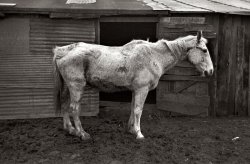
- Free Parking: 1940
- ... Dakota." 35mm nitrate negative by John Vachon for the Farm Security Administration. View full size.
The Case of the Missing Infant ... Posted by Dave - 11/21/2011 - 11:34am -
![Free Parking: 1940 November 1940. "Lunchroom. Aberdeen, South Dakota." 35mm nitrate negative by John Vachon for the Farm Security Administration. View full size.
The Case of the Missing InfantOne has to wonder if Martin Kane, private eye, is inside pitching the merits of Model pipe tobacco under the pretense of investigating the missing infant. Hap was left to fend for himself a thousand miles straight east, surrounded in his shop by his first love: endless supplies of Dill's Best, Old Briar, Model and Tweed pipe tobacco.
Abandoned babyIts amazing how often we see things in Shorpy photos that would be considered irrational and even illegal today. I can't imagine why a mother would even think of leaving her baby unattended outside a store.
[What makes you think there's a baby in there? - Dave]
Would the mother carry the baby in her arms while shopping?
[In case it's not ultra-obvious: This is a restaurant. - Dave]
Oops, so it is. I better get my glasses fixed. :-/
Not Much Of A Meal - Then or Now25 cents in 1940 is about $4.01 in 2011 money. The meal couldn't have been very large either date.
Park itJust leave the kid in the perambulator and catch a quick bite.
Watch your kids!Similar to this scene, and about the same time - my mother left my elder sister in the baby carriage while she went into the store (apparently a common thing back then). When she came out, the baby was gone. She screamed and shoppers came a-runnin'. They fanned out and caught a woman with my sister a block away. Her own baby had died and she needed a replacement I guess.
E A T To the point, nothing else, just EAT !
And for you Chesterfield fans "Made for smokers like yourself."
Bread and WaterOne has to wonder how anyone could serve a dinner for 25 cents, even in 1940, so we can only imagine what incredible gastronomic delights might have been on their dollar menu. I'm having trouble just trying to think of something edible that one can buy today for 2 bits and I keep coming up empty.
NOT abandoned babyI agree with Dave. There is probably no baby in the carriage. I imagine the mother took the child inside the diner with her.
The obviousWhat if Peterson objects?
Posh NoshA twenty-five cent meal in 1940 would be $3.84 today (courtesy of 'the inflation calculator'). Not really all that inexpensive.
Who's PetersonAnd why do they want me to eat his lunch?
(The Gallery, Eateries & Bars, John Vachon)](https://www.shorpy.com/files/images/SHORPY_8a32692a.thumbnail.jpg)
- Aerial Omaha: 1938
- ... to the West. Medium format negative by John Vachon for the Farm Security Administration. View full size.
Fans Anyone aware of what ... Posted by Dave - 09/14/2017 - 9:05pm -
![Aerial Omaha: 1938 UPDATE: Our vantage point for this view north along 14th Street is the Woodmen of the World tower at 1323 Farnam.
November 1938. "Omaha, Nebraska." Gateway to the West. Medium format negative by John Vachon for the Farm Security Administration. View full size.
FansAnyone aware of what the contraption is on top of the building on the left. I see fan units. Was this an air conditioning system? If so it is very narrow.
Three Corner TavernsInteresting to note the small corner taverns in the Omaha photographs: in the “Omaha Suds” image, in the Theodore's Place image, and the Oaks Tavern in this image. Three corner taverns, each about the same size and height, although some more decorated than the other. I wonder how many others existed?
Across the street is the Paris Bar and Billiards. Oaks and Paris advertised together.
What Depression?For a small city during the worst of the later Depression years, this photo portrays an impressive proportion of late model vehicles. As opposed to the trucks, the great majority of the cars seen here are within 3 or 4 years of age if not newer -- a mix probably not excelled in most U.S. localities today.
Brand new Ford TudorThe car almost directly in front of the "Nebraska" is a new 1938 Standard Ford V8. I've had one of these since the late 1970's. Once considered the ugly duckling of the 30's by almost everyone is now kinda good looking. Kinda.
Scorch marksSo what was the commercial establishment that burned at the corner of 14th and Capitol? Whatever it might have been, the fire appears to have thoroughly gutted the place.
Pay no attentionI'm assuming that this picture was taken from an airplane, so it's interesting that none of the many people on the street are looking up at the photographer. It seems like an airplane flying low over the downtown area would attract a lot of attention!
[The photo was taken from the Woodmen of the World building at 1323 Farnam Street. - Dave]
Gateway to the WestJust a minute, that nickname belongs to my native city, Winnipeg, Manitoba. But wait, Wikipedia points out that it also refers to no fewer than 6 cities in the US (Fargo, Fort Wayne, Omaha, St. Louis and the Gateway Arch, Kansas City, Pittsburgh) and one whole state (Oklahoma, although particularly Tulsa).
Location, Location, Location?I believe this photo was taken from a building on the southeast corner of 14th and Farnam. In an aerial photo from the early 1950s I can see a tall building located at that corner.
Furthermore, in that aerial photo I can clearly see the Hotel Fontenelle a few blocks to the west at 1806 Douglas and I can positively identify the fronts of the buildings in the 1300 block of Douglas where Palace Billiards and the Oaks Bar were.
[You are correct about the location (my first guess, the Hotel Fontenelle, is on the wrong block). Which means our vantage point is the 19-story Woodmen of the World headquarters, at the time of its completion in 1912 the tallest building between Chicago and the West Coast. - Dave]
No Apartments AvailableThe three story brick building being demolished was an apartment building offered for sale in January 1937. Directly across the street from it was the “Hummel Auto Shed” and the Omaha World Herald delivery truck garage and parking lot and the vacant space diagonally across the street was the site of the Jefferson Hotel, demolished in 1935.
Win some, lose someBetween the Oaks Bar and the Nebraska theater is a campaign office with banners for 19938 candidacies of (James T.) English for (Douglas) County Attorney, and (Frank) McGrath for (Douglas County) Clerk of Court. English won, and later became a state-court judge. McGrath, an incumbent mired in scandals, lost.
(The Gallery, John Vachon, Omaha, Railroads)](https://www.shorpy.com/files/images/SHORPY-8b14207a.thumbnail.jpg)
- The Hill: 1938
- ... size. 35mm nitrate negative by Arthur Rothstein for the Farm Security Administration.
The Hill? Which one? Which hill? Pittsburgh is ... Posted by Dave - 04/24/2011 - 10:46pm -
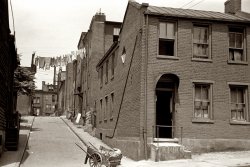
- Marja, Akbar, Stella May: 1938
- ... Donaldsonville, Louisiana." 35mm negative by Russell Lee, Farm Security Administration. View full size.
Free Parking Looks like ... Posted by Dave - 02/26/2012 - 4:19am -
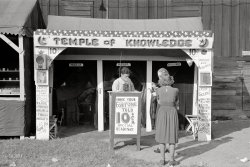
- Con Carny: 1939
- ... size. 35mm nitrate negative by Arthur Rothstein for the Farm Security Administration.
Four-Legged Girl The poster on the right ... Posted by Dave - 04/25/2008 - 10:34pm -
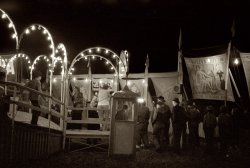
- Bank Nite: 1939
- ... Farmington, Minnesota." Photo by Arthur Rothstein for the Farm Security Administration. View full size.
The Lyric lives on A ... Posted by Dave - 12/22/2017 - 7:46pm -
![Bank Nite: 1939 September 1939. "Motion picture theatre. Farmington, Minnesota." Photo by Arthur Rothstein for the Farm Security Administration. View full size.
The Lyric lives onA brief history of The Lyric Theatre.
Shades of YesterdayPepsi Cola hits the spot
12 full ounces, that's a lot.
Twice as much and a nickel too.
Pepsi Cola is the drink for you.
Oak StreetThe theatre building remains, but is now an employment agency. In place of the popcorn stand is a bank branch. In place of the grocery store on the far right side of the photo is the office of the local newspaper, the Farmington Independent.
The names of the actors and actresses of the two films are forgettable, but for one: Linda Winters, in North of the Yukon. Her real name was Dorothy Comingore, and in a couple of years she'd appear as the second wife of Charles Foster Kane in a certain film that a young upstart named Orson Welles made. The Hollywood blacklist sealed her sad fate.
A fun family outingThe feature film this week takes the Jones Family to Los Angeles for the 1938 American Legion Convention. In the poster Mr Jones is seen in his American Legion Uniform. The Jones Family was a series of Fox B movies. Full disclosure: I am a member of the American Legion.
Unless The Theater Owned It-----the popcorn stand OUTSIDE had to be a real drag for the operators of the movie house concession.
The reason 7-Up liked you back then is because, until 1948, it contained lithium citrate, a mood stabilizing drug used for things like manic depression.
PatronsI wonder how many seats were in the theater?
[Answered in a link in an earlier comment. -tterrace]
Charles StarrettSoon to leave the Mounties and become that cowboy terror of evildoers - the Durango Kid. Next to Roy, he was my favorite.
Pop Corn vs PopcornWas the term "Pop Corn" a regional variation? When did the popular vernacular change to "Popcorn"?
Spring ByingtonI very much remember watching Spring Byington on TV on "December Bride" when I was a kid. She also appeared in a series of Jones Family movies.
Bank Nite"Bank Nite" was a franchised lottery, the purpose obviously being to draw people to the theater. Prizes were awarded based on names being drawn and you had to be present to win.
(The Gallery, Arthur Rothstein, Movies, Small Towns)](https://www.shorpy.com/files/images/SHORPY-8b18415a1.thumbnail.jpg)
- Time and Tide: 1941
- ... Medium format acetate negative by Russell Lee for the Farm Security Administration. View full size.
Promenade Home These folks ... Posted by Dave - 03/18/2022 - 9:55pm -
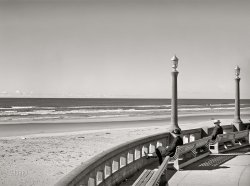
- Well, Well: 1941
- ... format acetate negative by Marion Post Wolcott for the Farm Security Administration. View full size.
Tetanus Anyone? Our little ... Posted by Dave - 10/04/2019 - 8:36am -
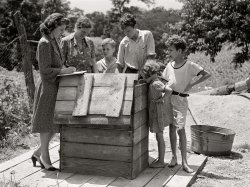
- Feed Shed: 1936
- April 1936. "Farm boys. Jackson County, Ohio." 35mm nitrate negative by Theodor Jung for the Farm Security Administration. View full size.
Just add water The East River, ... Posted by Dave - 12/04/2011 - 11:17am -
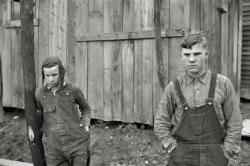
- The Stag Table: 1940
- ... Farms. Pinal County, Arizona." Photo by Russell Lee, Farm Security Administration. View full size.
A Cooperative is not Socialism ... Posted by Dave - 12/03/2020 - 1:37pm -
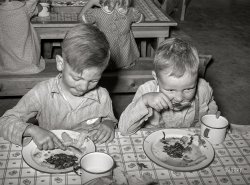
- Stepping Out: 1941
- ... full size. 4x5 nitrate negative by Arthur Siegel for the Farm Security Administration.
I Want... Those shoes. Mind you, I wouldn't say ... Posted by Dave - 09/11/2011 - 11:02am -
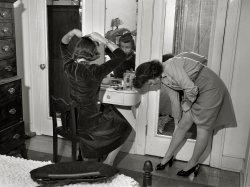
- Idaho Chief: 1941
- ... Caldwell, Idaho." Acetate negative by Russell Lee for the Farm Security Administration. View full size.
Turn around, Bright Eyes I ... Posted by Dave - 07/11/2021 - 5:39pm -
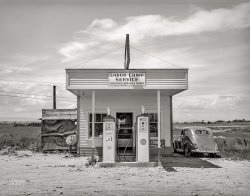
- Jars of Plenty: 1939
- ... County, Missouri." Photo by Arthur Rothstein for the Farm Security Administration. View full size.
Some can can However, I do ... Posted by Dave - 02/02/2018 - 2:42pm -
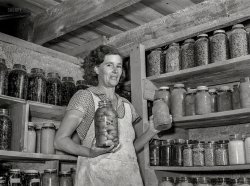
- Tony and Maria: 1935
- ... cemetery." 8x10 nitrate negative by Walker Evans for the Farm Security Administration. View full size.
The house over Maria's shoulder is ... Posted by Dave - 04/06/2011 - 12:30pm -
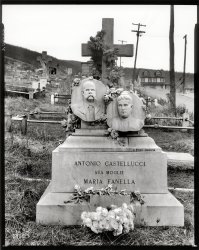
- Wild Animal Circus: 1936
- ... Carolina. 35mm nitrate negative by Walker Evans for the Farm Security Administration. View full size.
Cole Bros It looks like the ... Posted by Dave - 12/27/2007 - 8:53pm -
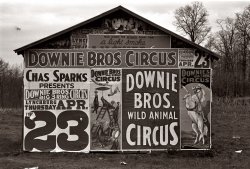
- Black Belt Barber: 1941
- ... full size. 35mm safety negative by Edwin Rosskam for the Farm Security Administration.
"Specailize"? Hair "cuting"? Ouch. ... Posted by Dave - 09/09/2011 - 2:16pm -
![Black Belt Barber: 1941 April 1941. South Side Chicago. "Barber shop in the Black Belt." View full size. 35mm safety negative by Edwin Rosskam for the Farm Security Administration.
"Specailize"?Hair "cuting"? Ouch. I hope they didn't pay that sign painter too much!
[Long hair? So not cute. "Hey barber. Cute my 'do." - Dave]
SpellingThey also missed with "straightner."
Stocking CapAppears that the barber is wearing a stocking cap. These were made from a woman's stocking, usually worn overnight for the purpose of setting a day-long "permanent". I did this up to about age 16 (that would be 1955).
Stocking Cap...Black men wore (and still do) wear tight elastic caps to set tight, close waves in their hair. "Conking," or perming the hair straight and then keeping it together for a night out, was done with a "do-rag," which is a bit different.
In his autobiography, Malcolm X talks about the pain of those crude perming chemicals burning his scalp, and what can go wrong when you start the process only to find your pipes frozen and no water flowing to wash that stuff out!
And yeah, I wore a stocking cap too until I was about 20... Great photo.
Do RagsWas there a name for the knit do rags that were open on top? There is no information whatsoever about these on the web, or not that I have found.
[That's a stocking cap. - Dave]
(The Gallery, Chicago, Edwin Rosskam, Stores & Markets)](https://www.shorpy.com/files/images/8a15866u1.thumbnail.jpg)
- Foot Traffic: 1941
- ... last seen here . Acetate negative by John Vachon for the Farm Security Administration. View full size.
I'm waiting for a ... Posted by Dave - 01/10/2020 - 5:04pm -
